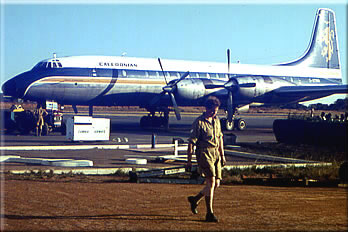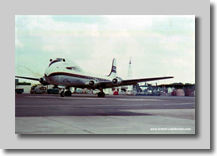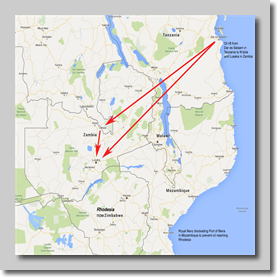The Zambian Oil Lift
1965-1966
1965-1966


Please, if you have any photo's you can share or show on this site, please drop me aline anytime, email Dave
Don't forget to see all the other pages in Special Features
On 11th November 1965 Rhodesia (now Zimbabwe) announced that it considered itself an independent sovereign state. The declaration of UDI, Unilateral Declaration of Independence, followed lengthy but unresolved negotiations over Rhodesian independence from Britain.
Both Britain and the United Nations considered this move by Rhodesia illegal and both imposed sanctions on Ian Smith’s Government and Rhodesia.
Rhodesia had been a self-governing British Territory since 1923 and this was the unilateral break from Britain since that of the United States in 1776.
One of the sanctions imposed on Rhodesia was an embargo on oil imports. But when Rhodesia still continued to receive oil via Portuguese Mozambican ports a squadron of Royal Navy ships was sent to blockage those ports. This blockade was endorsed by a UN Security Council Resolution a few weeks later. The UN would then issue their first ever trade sanctions against any country in December 1966; this required all UN countries to cease trade with Rhodesia. (Though Rhodesia succussfully continued trading with various countries and the sanctions had had little effect on Rhodesia).
But Zambia, another British territory, was completely dependent on Rhodesia for all its oil supplies and Rhodesia’s first act was to cut off all oil to Kenneth Kaunda’s Zambia. Thus Zambia would be severly affected by the sanctions against Rhodesia.
Thus there was an emergency need to transport oil to Zambia and on 19th December two RAF Britannia aircraft positioned to Dar es Saleem in Tanzania in readiness to start flying oil the 900 miles to Zambia. This soon rose to nine RAF Britannia aircraft from Transport Command to ensure Zambia was supplied with oil. President Kaunda expressed his confidence in the ability of Britain to keep Zambia supplied with essential oil.
But Tanzania objected to having 90 British military personnel essentially based on its soil and this caused a brief rift an Anglo-Tanzanian relations.
Both Britain and the United Nations considered this move by Rhodesia illegal and both imposed sanctions on Ian Smith’s Government and Rhodesia.
Rhodesia had been a self-governing British Territory since 1923 and this was the unilateral break from Britain since that of the United States in 1776.
One of the sanctions imposed on Rhodesia was an embargo on oil imports. But when Rhodesia still continued to receive oil via Portuguese Mozambican ports a squadron of Royal Navy ships was sent to blockage those ports. This blockade was endorsed by a UN Security Council Resolution a few weeks later. The UN would then issue their first ever trade sanctions against any country in December 1966; this required all UN countries to cease trade with Rhodesia. (Though Rhodesia succussfully continued trading with various countries and the sanctions had had little effect on Rhodesia).
But Zambia, another British territory, was completely dependent on Rhodesia for all its oil supplies and Rhodesia’s first act was to cut off all oil to Kenneth Kaunda’s Zambia. Thus Zambia would be severly affected by the sanctions against Rhodesia.
Thus there was an emergency need to transport oil to Zambia and on 19th December two RAF Britannia aircraft positioned to Dar es Saleem in Tanzania in readiness to start flying oil the 900 miles to Zambia. This soon rose to nine RAF Britannia aircraft from Transport Command to ensure Zambia was supplied with oil. President Kaunda expressed his confidence in the ability of Britain to keep Zambia supplied with essential oil.
But Tanzania objected to having 90 British military personnel essentially based on its soil and this caused a brief rift an Anglo-Tanzanian relations.
On Sunday 25th December 1965 it was reported that cargo aircraft chartered from four British Airlines would begin to take over the oil lift....in two days’ time.
Caledonian and British United Airways were two of the airlines contracted to fly oil between Tanzania and Zambia. Caledonian positioned Britannias and BUA sent Carvair’s; though operating in Air Ferry titles and Air Ferry DC4’s were deployed.
The first Caledonian Britannia left Gatwick on 28th December 1965, with 109 relief RAF crew on board, bound for Lusaka via Nairobi. They dropped the RAF personnel off and flew on to Dar es Salaam, where the seats were removed and the aircraft readied for carrying oil drums.
Each Britannia flight could carry 2,250 gallons of oil in drums, whilst using 2,700 gallons of fuel itself on the return trip from Tanzania to Zambia. In all Caledonian transported 1,411,518 gallons of oil over 630 flights.
Caledonian and British United Airways were two of the airlines contracted to fly oil between Tanzania and Zambia. Caledonian positioned Britannias and BUA sent Carvair’s; though operating in Air Ferry titles and Air Ferry DC4’s were deployed.
The first Caledonian Britannia left Gatwick on 28th December 1965, with 109 relief RAF crew on board, bound for Lusaka via Nairobi. They dropped the RAF personnel off and flew on to Dar es Salaam, where the seats were removed and the aircraft readied for carrying oil drums.
Each Britannia flight could carry 2,250 gallons of oil in drums, whilst using 2,700 gallons of fuel itself on the return trip from Tanzania to Zambia. In all Caledonian transported 1,411,518 gallons of oil over 630 flights.


Caledonian Britannia on station (Photo UKMAMS)
Oil drums loaded on a Britannia (Photo UKMAMS)
Look at Life's film of the Oil Lift




